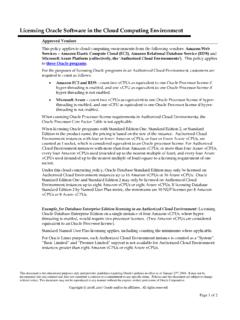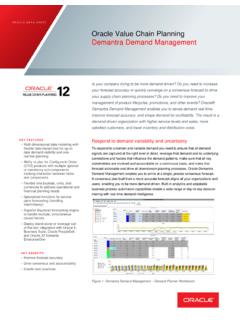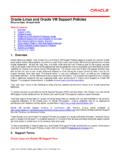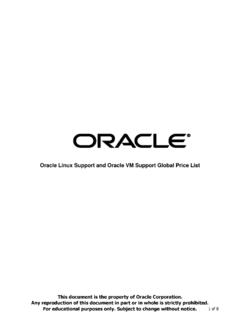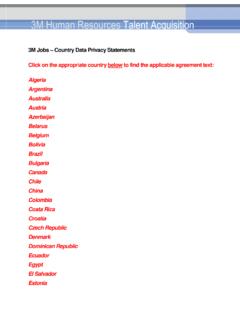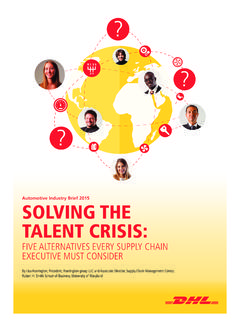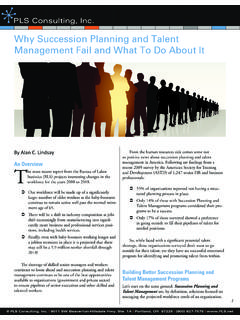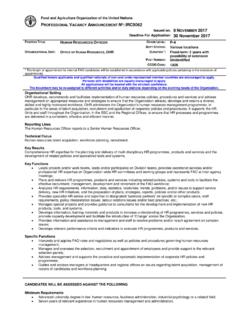Transcription of Talent Retention Best Practices
1 An Oracle White Paper June 2012 Talent Retention : Six Technology-Enabled Best Practices Talent Retention : Six Technology-Enabled Best Practices Introduction .. 1 Recruit the Right People in the First Place .. 4 Retention Recipe: Recruit Right .. 6 Improve Line Management 6 Retention Recipe: Manager Excellence .. 8 Constant Feedback on Clear Goals .. 8 Retention Recipe: Clear Goals, Frequent Feedback .. 11 Empower Employee Career Management .. 11 Retention Recipe: Career Planning .. 13 Proactively Drive Talent Mobility .. 13 Retention Recipe: Talent Mobility .. 16 Continuously Measure and Improve .. 16 Retention Recipe: Metrics and Analytics .. 18 Conclusion: Technology-Based Best Practices Drive Retention .
2 18 Talent Retention : Six Technology-Enabled Best Practices 1 Introduction The importance of top-performer Retention is a topic that consistently leads in HR and business surveys alike. Notably, more than 1,000 CEOs were asked, How important are the following sources of competitive advantage in sustaining your growth over the long term? The #1 response chosen by 97 percent was access to, and Retention of, key Talent . 1 Talent Retention is critically important for all organizations for two main reasons: 1. Turnover is expensive. 2. Top performers drive business performance. Although estimated financial impacts from turnover fluctuate depending on industry, position, and location, estimates range from 30 percent to 250 percent of annual Turnover costs mount steeply, arising from the direct replacement costs of Talent acquisition, the opportunity costs of vacant positions and time to productivity, and more broadly lost business performance.
3 The impact of quality performers was crystallized in McKinsey s seminal War for Talent study. It found that, in the opinion of senior managers, high performers outperform average performers by a wide margin. According to the study, high performers in operations roles are able to increase productivity by 40 percent, high performers in management roles increase profits by 49 percent, and, in sales positions, high performers are responsible for 67 percent greater 1 PricewaterhouseCoopers, 12th Annual Global CEO Survey, 2009. 2 Employees Leaving? Here s Why and What You Can Do, The New York Times, October 24, 2008. 3 McKinsey & Company, The War for Talent , 1998.
4 Talent Retention : Six Technology-Enabled Best Practices 2 Constrained economic conditions further highlight the need for organizations to keep their best people as companies strive to control costs and increase productivity. Talent management strategies address this dual agenda directly. For example, a Taleo Research4 global survey found 70 percent of respondents see an increased need to retain top performers by driving focus on performance management and career planning in a low-growth low Talent Retention produces a substantial drain on corporate resources, leaders need to know which Practices work and what they should focus on to retain and motivate their workforce.
5 For instance, a Talent management strategy that allows employees to build a network, seek and find mentors, and help them grow and develop while feeling more connected and engaged is one means of retaining Talent . There are many approaches that have been explored as levers to increase Retention , including compensation packages and rewards, benefits, telecommuting options, and work/life balance initiatives. Each may have a place in a company s portfolio of Retention strategies. Today, certain Talent management Practices that utilize self-service software as a service (SaaS) interfaces can be effective and extensible throughout organizations. Specifically, Retention strategies can be carried out through Talent management Practices supported by a robust technology platform.
6 These Practices span the Talent lifecycle from hiring, to managing employee performance and alignment with corporate goals, to providing career and promotion opportunities, to measuring program success. 4 Taleo was acquired by Oracle in June 2012. 5 Taleo Research with Human Capital Institute (HCI), Business Intelligence, and Markess International, Quantum Market Research Global Unified Talent Management Survey, 2008. Talent Retention : Six Technology-Enabled Best Practices 3 This paper focuses on six key Practices that organizations can implement with technology support to retain their top Talent : 1. Recruit the right people in the first place. 2.
7 Improve the line manager s ability to manage. 3. Give employee s constant feedback about clear, meaningful goals. 4. Empower employees to manage their own careers. 5. Proactively drive Talent mobility. 6. Continuously measure and improve Retention strategies. Talent Retention : Six Technology-Enabled Best Practices 4 Recruit the Right People in the First Place Retaining top performers begins with hiring the right Talent in the first place. Top performers will be strong contributors employees who are valuable and organizations want to retain. Likewise, employees who are a good fit for the position and perform well will want to stay with the organization.
8 During the Talent acquisition process, organizations can identify potential top performers by analyzing the needed skills, experience, and fit, and matching those to the Talent profiles of external candidates. That method of effective recruiting requires a streamlined process. Automated skills-based matching and automated workflow enable recruiters and hiring managers to focus on evaluating a short list of quality candidates. Building Talent pools of suitable candidates proactively provides prospective quality hires, as well as lowering sourcing drive quality into a selection and recruiting process, the company first defines which quality is for each position in the company.
9 The selection process should be grounded on the foundation of a proper specification of the requirements of the job. The staffing department should work with hiring managers to set out the criteria that will bring about success at a job, including: Knowledge, skills, and abilities Attitude and motivation Cultural fit, both with the organization and with its customers Figure 1. Automated skills-based matching allows recruiters to focus on a short list of quality candidates. 6 Taleo Research, Recruiting: Reducing Direct Costs and Reaping Results, 2009. Talent Retention : Six Technology-Enabled Best Practices 5 The more specific the criterion, the better the company is able to calibrate the selection process and measure for a quality outcome.
10 Once set, these criteria for the ideal candidate for a position inform all aspects of the recruiting process for the position, from the writing of the job description to the criteria employed by an online prescreening function. The criteria of selection and of performance must be aligned, to ensure that the staffing process reliably selects the qualities and characteristics that promote high-quality performance on the job. Organizations need the right tools and technology so their managers can make higher-quality hiring decisions and effectively recruit to retain. They need to be clear about competencies required for success, then base their hiring decisions from the success criteria or success templates they have developed based on their top performers.
